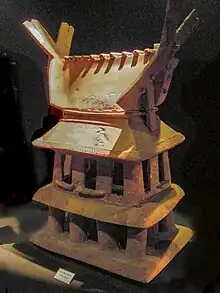Imashirozuka Kofun
Imashirozuka Kofun (今城塚古墳) is a Kofun period keyhole-shaped burial mound, located in the Gungeshinmachi neighborhood of the city of Takatsuki, Osaka in the Kinai region of Japan. The tumulus was designated a National Historic Site of Japan in 1958, with the area under protection expanded in 2006.[1] It is the largest kofun in the Yodo River basin and one of the largest constructed in the first half of the 6th century. Although it has not been sanctioned by the Imperial Household Agency, there is a strong theory that it is the true tomb of the 26th Emperor Keitai.
今城塚古墳 | |
 Imashirozuka Kofun | |
 Imashirozuka Kofun  Imashirozuka Kofun (Japan) | |
| Location | Takatsuki, Osaka, Japan |
|---|---|
| Region | Kinai region |
| Coordinates | 34°51′0.92″N 135°35′38.99″E |
| Type | Kofun |
| History | |
| Founded | 6th century |
| Periods | Kofun period |
| Site notes | |
| Excavation dates | 1997-2007 |
| Public access | Yes (on site museum) |

Overview
The Imashirozuka Kofun is a zenpō-kōen-fun (前方後円墳), which is shaped like a keyhole, having one square end and one circular end, when viewed from above. It is located almost in the center of the Mishima Plain. Orientated to the west, the mound is surrounded by a double moat with a total length of about 350 meters and width of 340 meters. The main tumulus is accompanied by several baicho auxiliary tumuli. The tumulus proper has a length of 190 meters. Based on historical characteristics such as the shape and haniwa, as well as documentary materials such as "Kojiki", "Nihon Shoki", and "Engishiki", it is presumed that the tomb of the great king of the Yamato regime in the 6th century. This corresponds to the time of the semi-legendary Emperor Keitai, and a committee of historians and archaeologists recommended that this kofun be designated as his official burial place. However, this was rejected by the Imperial Household Agency, which had already designated the Ōta Chausuyama Kofun in Ibaraki, Osaka, some 1.3 kilometers to the west, as Emperor Keitai's mausoleum, despite the fact that it is believed to have been constructed in the middle of the 5th century, before Emperor Keitai's reign. [2]
The tumulus was severely damaged in the Sengoku period when used as a fortress when Oda Nobunaga attacked the Miyoshi clan in his invasion of Settsu Province in 1568. It is also recorded that a portion of the tumulus collapsed due to a landslide caused by the 1596 Keichō–Fushimi earthquake. [2]
Since 1997, Takatsuki City has continued to conduct archaeological excavations to obtain information for developing the site into an archaeological park. A very large quantity of haniwa have been recovered, including 170-cm tall house-shaped haniwa (the largest discovered in Japan) and elaborate warrior haniwa, as well as haniwa depicting falconers, wrestlers, shrine maidens, seated boys, horses, chicken and other animals. These haniwa were mostly from the inner bank dividing the two moats. Some of these artifacts are displayed at the Imashirozuka Ancient History Museum (今城塚古代歴史館) at site.[2]
About 1.5 kilometers west of Imashirozuka Kofun is the Araike Haniwa Production site . This is one of the oldest and largest haniwa workshops known, and was in operation for about 100 years from the middle of the 5th century to the middle of the 6th century.Excavations confirmed three large-scale haniwa workshops, 18 kilns, and a village for craftsmen. In 2006, it was added to the National Historic Site designation. The site is about a 25-minute walk from Settsu-Tonda Station on the JR West Kyōto Line or Tomita Station on the Hankyu Kyoto Main Line[2]
References
- "今城塚古墳 附新池埴輪製作遺跡" (in Japanese). Agency for Cultural Affairs. Retrieved August 22, 2022.
- Isomura, Yukio; Sakai, Hideya (2012). (国指定史跡事典) National Historic Site Encyclopedia. 学生社. ISBN 4311750404.(in Japanese)
External links
![]() Media related to Imashirozuka-kofun at Wikimedia Commons
Media related to Imashirozuka-kofun at Wikimedia Commons
- Takatsuko City History Web City(in Japanese)